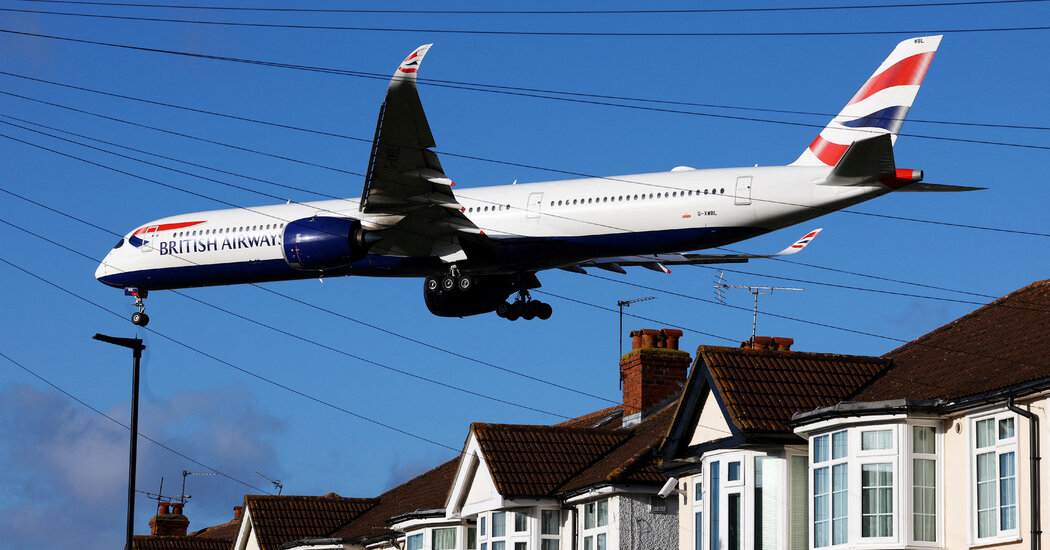This article was updated on April 2, 2025, with information about pricing and who needs to apply for the travel authorization.
Travelers from the United States, Canada and most European countries who do not require visas to enter the United Kingdom will now need to apply for digital authorization in order to visit or, in some cases, transit through the country.
The electronic travel authorization, called ETA and linked to a traveler’s passport, lasts two years. The requirement was introduced in late 2023 for nationals of Qatar, Saudi Arabia and four other Gulf nations and now extends to all visa-exempt travelers visiting the United Kingdom, including those from the European Union.
Some travelers connecting through airports in the United Kingdom will also need to apply for the ETA, but only if they pass through border control.
The ETA system is part of a mission to “deliver a more streamlined, digital immigration system” that will enhance border security, according to a news release from the British Home Office.
Here’s what you need to know about the ETA and the process to apply.
It’s not a visa.
The ETA is for short-term visits under six months and only for visa-exempt travelers; the full list of applicable nationalities is available online. The ETA does not replace existing visa policies, which require citizens of dozens of countries and territories to apply for and receive a visa to enter the United Kingdom.
British and Irish citizens, visa holders, and those granted permission to live, work or study in the United Kingdom do not need to apply for the ETA.
The ETA doesn’t replace the need for passports to enter the United Kingdom.
Travelers can apply online or through an app.
Applications are accepted online or through the ETA app.
All travelers, including infants and children, will need ETAs, though applications can be submitted on behalf of other travelers.
To apply, you’ll need the applicant’s passport, photo and payment. Credit cards, debit cards, Apple Pay and Google Pay are accepted forms of payment. You’ll be asked to answer a set of security questions and to provide contact information. Details about your travel plans are not necessary.
The price, 10 pounds or around $13, will rise to £16 or about $21, as of April 9.
Most decisions will be rendered within three days, according to the British government, and travelers will be notified by email.
The ETA is valid for multiple journeys over a two-year period, but if your passport expires earlier, so does your ETA. It’s linked to your passport, which means there is no physical document.
Rejected applicants can apply again.
Though ETA processing is mostly automated, a caseworker will review an application before it’s rejected or refused, said Kelly Chua, a director at the global immigration firm Fragomen.
Travelers who have their ETA applications rejected can apply again, and they will be told why their application was unsuccessful. A rejection could stem from an incomplete application, such as biometrics not being captured, Ms. Chua added.
Applicants who are not granted an ETA will need to apply for a visa. Reasons applicants could be refused include previous cancellation of a visa, having unpaid litigation costs, using false documents, and a recent criminal conviction, according to the British Home Office.
As of April 2, most Europeans are required to have an ETA.
Applications for travelers from 34 European nations opened on March 5.
An exception exists for legal residents of Ireland. Those travelers do not need an ETA if they enter the United Kingdom from Ireland, Jersey, Guernsey or the Isle of Man.
The ETA is distinct from ETIAS.
The European Union is planning to enact a similar program for visa-exempt travelers, called the European Travel Information and Authorization System, or ETIAS. That program has been repeatedly delayed, and is now expected to begin sometime in 2026.
This travel authorization, required to enter 30 European countries, will cost 7 euros, or roughly $7. This will apply to an estimated 1.4 billion people from countries including the United Kingdom, Australia and the United States who can currently travel visa-free throughout much of Europe.
Follow New York Times Travel on Instagram and sign up for our Travel Dispatch newsletter to get expert tips on traveling smarter and inspiration for your next vacation. Dreaming up a future getaway or just armchair traveling? Check out our 52 Places to Go in 2025.


